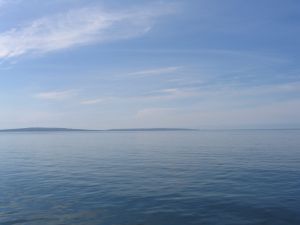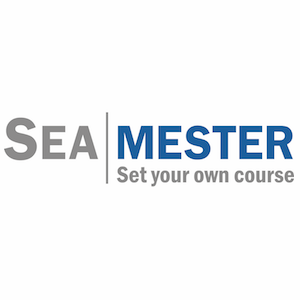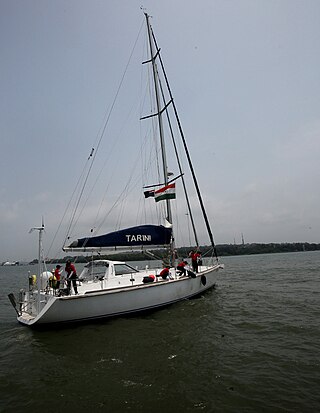Related Research Articles

Clipperton Island is an uninhabited, 6 km2 (2.3 sq mi) coral atoll in the eastern Pacific Ocean. It is 10,677 km (6,634 mi) from Paris, France, 5,400 km (2,900 nmi) from Papeete, Tahiti, and 1,080 km (580 nmi) from Mexico. It is an overseas state private property of France under direct authority of the Minister of the Overseas. In the past, Clipperton Island was the subject of a sovereignty dispute in particular between France and Mexico, which was finally settled through arbitration in 1931; the Clipperton Island Case remains widely studied in international law textbooks.

The Northwest Passage (NWP) is the sea route between the Atlantic and Pacific oceans through the Arctic Ocean, along the northern coast of North America via waterways through the Canadian Arctic Archipelago. The eastern route along the Arctic coasts of Norway and Siberia is accordingly called the Northeast Passage (NEP). The various islands of the archipelago are separated from one another and from Mainland Canada by a series of Arctic waterways collectively known as the Northwest Passages, Northwestern Passages or the Canadian Internal Waters.

Circumnavigation is the complete navigation around an entire island, continent, or astronomical body. This article focuses on the circumnavigation of Earth.

Galleons were large, multi-decked sailing ships first used as armed cargo carriers by European states from the 16th to 18th centuries during the age of sail and were the principal vessels drafted for use as warships until the Anglo-Dutch Wars of the mid-1600s. Galleons generally carried three or more masts with a lateen fore-and-aft rig on the rear masts, were carvel built with a prominent squared off raised stern, and used square-rigged sail plans on their fore-mast and main-masts.

USS Vincennes was a 703-ton Boston-class sloop of war in the United States Navy from 1826 to 1865. During her service, Vincennes patrolled the Pacific, explored the Antarctic, and blockaded the Confederate Gulf coast in the Civil War. Named for the Revolutionary War Battle of Vincennes, she was the first U.S. warship to circumnavigate the globe.

Victoria was a carrack and the first ship to successfully circumnavigate the world. Victoria was part of the Spanish expedition to the Moluccas commanded by the explorer Ferdinand Magellan until his death in the Philippines in 1521. The expedition began on 10 August 1519 with five ships. However, only two reached their goal in the Moluccas. Thereafter, Victoria was the only ship to complete the return voyage, under Juan Sebastián de Elcano's command, crossing uncharted waters of the Indian Ocean to sail around the world. She returned to Sanlúcar de Barrameda, Spain on 6 September 1522.

Ocean exploration is a part of oceanography describing the exploration of ocean surfaces. Notable explorations were undertaken by the Greeks, the Romans, the Polynesians, the Phoenicians, Phytheas, Herodotus, the Vikings, the Portuguese and Muslims. Scientific investigations began with early scientists such as James Cook, Charles Darwin, and Edmund Halley. Ocean exploration itself coincided with the developments in shipbuilding, diving, navigation, depth, measurement, exploration, and cartography.

Cape Horn is the southernmost headland of the Tierra del Fuego archipelago of southern Chile, and is located on the small Hornos Island. Although not the most southerly point of South America, Cape Horn marks the northern boundary of the Drake Passage and marks where the Atlantic and Pacific Oceans meet.

Seamester is part of the Global Expeditions Group, an organization that offers academic, study abroad programs on board three sailing vessels, Ocean Star, Argo and Vela. Sea|mester began running programs in 1998 as an extension from its sister organization ActionQuest. A full semester's course load is offered on board including classes in Oceanography, Marine Biology, Professional Skipper Certification Training, Leadership, Basic Seamanship, and an Independent Research Project. Courses are accredited through the University of South Florida (USF).

The Galathea expeditions comprise a series of three Danish ship-based scientific research expeditions in the 19th, 20th and 21st centuries, carried out with material assistance from the Royal Danish Navy and, with regard to the second and third expeditions, under the auspices of the Danish Expedition Foundation. All three expeditions circumnavigated the world from west to east and followed similar routes.

Project Kaisei is a scientific and commercial mission to study and clean up the Great Pacific Garbage Patch, a large body of floating debris trapped in the Pacific Ocean by the currents of the North Pacific Gyre. Discovered by NOAA, the patch is estimated to contain 20 times the density of floating debris compared to the global average. The project aims to study the extent and nature of the debris with a view to capturing, detoxifying, and recycling the material, and is organised by the Ocean Voyages Institute, a California-based 501c3 non-profit organisation dealing with marine preservation. The project is based in San Francisco and Hong Kong.

MS Tûranor PlanetSolar, known under the project name PlanetSolar, founded by the Swiss explorer Raphaël Domjan, is the largest solar-powered boat in the world and launched on 31 March 2010.

The era of European and American voyages of scientific exploration followed the Age of Discovery and were inspired by a new confidence in science and reason that arose in the Age of Enlightenment. Maritime expeditions in the Age of Discovery were a means of expanding colonial empires, establishing new trade routes and extending diplomatic and trade relations to new territories, but with the Enlightenment scientific curiosity became a new motive for exploration to add to the commercial and political ambitions of the past. See also List of Arctic expeditions and List of Antarctic expeditions.
James Wharram was a British multihull pioneer and designer of catamarans.

Trishna is a Swan 37 yacht belonging to the Corps of Engineers of the Indian Army. The name Trishna means “to thirst for” in the Sanskrit language. The 1970-vintage boat, earlier known as Guinevere of Sussex, was purchased in 1984 from the United Kingdom. The yacht has since been used for long distance ocean sailing and training. The first of the yachts' journeys after it was acquired was its voyage from Gosport to Mumbai, India. Subsequently, the yacht embarked on its most notable voyage, the circumnavigation of the globe from 1985 to 1987. This was the first such achievement by an Indian crew. In subsequent years, the yacht has been used for international cruises primarily in the Indian Ocean region and is currently still operational.

Tall ship Atyla is a two-masted wooden schooner handmade in Spain between 1980 and 1984. She was designed by Esteban Vicente Jimenez to look like the Spanish vessels from the 1800s and built with the intention of circumnavigating the earth following the Magellan–Elcano route and then become a training ship. Although she never did that trip and instead sailed around Spain for almost her 30 years, in 2013 Esteban’s nephew became her new skipper and decided to finally dedicate her to international sail training for both professionals and amateurs.

INSV Tarini is the second sailboat of the Indian Navy. She was constructed at Aquarius Shipyard located in Goa. After undergoing extensive sea trials, she was commissioned to Indian Navy service on 18 February 2017.

Navika Sagar Parikrama was a circumnavigation of the globe by female officers of the Indian Navy. The six-member all-woman team circumnavigated and managed the whole operation in their first-ever global journey, on INSV Tarini. The voyage lasted 254 days, from 10 September 2017 to 21 May 2018, with only 4 port calls, in Fremantle, Australia; Lyttelton, New Zealand; Port Stanley, Falkland Islands; and Cape Town, South Africa, and a forced technical halt at Port Louis, Mauritius, crossing the equator twice and passing through 3 oceans. The voyage was originally set to start on September 5, 2017, but a 5-day delay happened so that Nirmala Sitharaman, who was recently appointed defense minister, could flag off the crew. The boat returned to INS Mandovi in Goa after travelling 21,600 nautical miles. The voyage was showcased in Tarini, a documentary jointly produced by National Geographic and the Indian Navy, premiering at an event at Lady Shri Ram College on 8 March to mark International Women's Day. The voyage prompted National Geographic to start the "Girls Who Sailed" campaign, to tell tales of "grit and determination".

Captain Dilip Donde is a retired Indian Naval officer and the first Indian to complete a solo, unassisted circumnavigation of the globe under sail. From April 2006 to May 2010 he planned and executed Project 'Sagar Parikrama' which involved constructing a sailboat in India and then sailing it around the world. He was the hundred and ninetieth person to complete the journey solo.
Saildrone, Inc. is a United States company based in Alameda, California, that designs, manufacturers, and operates a fleet of unmanned/uncrewed surface vehicles (USVs), or ocean drones, known as "saildrones". The company was founded by engineer Richard Jenkins in 2012.
References
- ↑ L, C. (2020-07-18). "Home". Fondation Pacifique. Retrieved 2023-01-04.
- ↑ L, C. (2020-11-04). "Anciennes expéditions". Pacifique (in French). Retrieved 2023-01-04.
- ↑ "OME - Accueil". omexpedition.ch. Retrieved 2023-01-04.